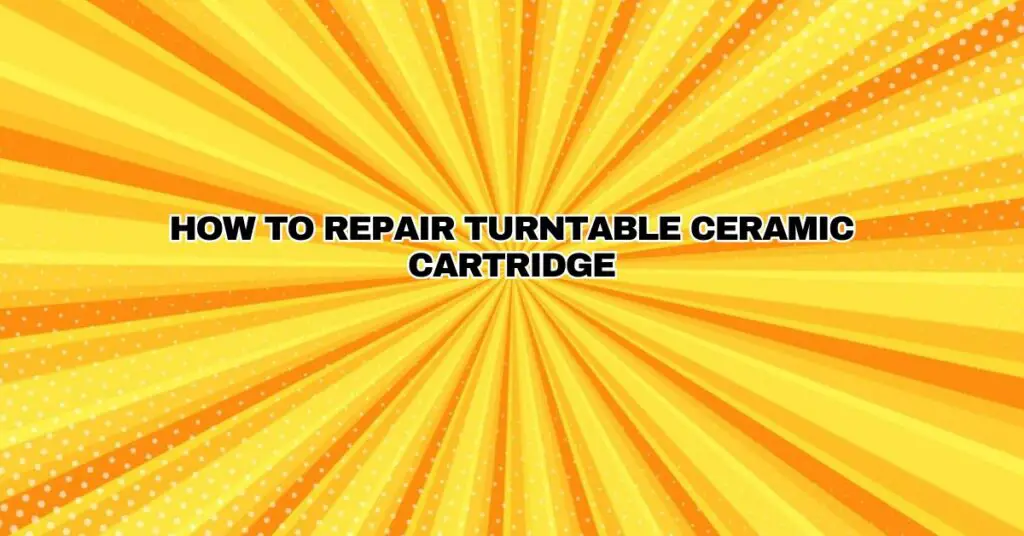A turntable’s ceramic cartridge is a critical component that converts the mechanical vibrations from the stylus into electrical signals, allowing you to enjoy the sweet sound of your vinyl records. Over time, these cartridges may experience wear and tear, affecting the audio quality. If your turntable’s ceramic cartridge is not performing as it should, repairing it may be a cost-effective solution to restore your vinyl listening experience. In this comprehensive guide, we will walk you through the steps to repair a ceramic cartridge, allowing you to enjoy the full fidelity of your cherished vinyl records.
Before You Begin: Gather Your Tools and Materials
To repair a ceramic cartridge, you’ll need some tools and materials. Ensure you have the following items on hand:
- Replacement Parts: If you’ve identified the specific issue with your cartridge, you may need replacement components such as a new stylus, wires, or connectors.
- Work Surface: Choose a clean, well-lit area with enough space to comfortably perform the cartridge repair.
- Soldering Iron and Solder (if required): Some cartridge repairs involve soldering wires or connectors, so having these tools is essential.
- Screwdriver: A small Phillips-head or flathead screwdriver may be necessary to access and repair the cartridge.
- Multimeter: An electrical tester like a multimeter can be helpful for diagnosing and ensuring proper connectivity during the repair.
- Cleaning Supplies: Isopropyl alcohol, a soft brush, and lint-free cloths for cleaning cartridge components.
Step 1: Turn Off and Unplug Your Turntable
Before you begin any repair work, ensure your turntable is turned off and unplugged from the power source to prevent any electrical hazards or accidents.
Step 2: Diagnose the Issue
- Examine your cartridge to identify the specific issue. Common problems may include a worn stylus, loose wires, or damaged connectors. Identifying the issue is crucial for an effective repair.
Step 3: Replace the Stylus (Needle)
- If the stylus is visibly worn or damaged, replacing it is often the most straightforward and effective repair. Remove the old stylus by gently detaching it from the cartridge, and attach the new one securely.
Step 4: Check and Repair Wiring and Connections
- Inspect the wires and connectors. Loose or damaged wires can lead to poor audio quality. If you find any issues, solder or reattach the wires securely to their respective connectors.
Step 5: Clean the Cartridge Components
- Use isopropyl alcohol and a soft brush to clean the cartridge components, ensuring they are free from dust, dirt, and residue. Clean connectors and terminals thoroughly to ensure a proper connection.
Step 6: Test the Cartridge
- Use a multimeter to check the electrical connectivity within the cartridge. This helps ensure that the stylus and connections are functioning correctly.
Step 7: Reassemble and Test
- Reassemble any components that were removed during the repair.
- Plug in and turn on your turntable, and play a record to ensure that the repaired ceramic cartridge is functioning correctly and that the audio quality has improved.
Step 8: Fine-Tuning and Adjustments (If Necessary)
- If you notice any tracking or sound quality issues after the repair, you may need to make minor adjustments to the cartridge’s alignment, tracking force, and anti-skate settings. Consult your turntable’s user manual for guidance.
By following these steps and handling the repair process with care and attention to detail, you can often restore your ceramic cartridge’s performance, allowing you to continue enjoying your vinyl records with optimal audio quality. If, after thorough troubleshooting and repair attempts, the cartridge still doesn’t function correctly, consider seeking assistance from a professional turntable technician to diagnose and resolve the issue.

